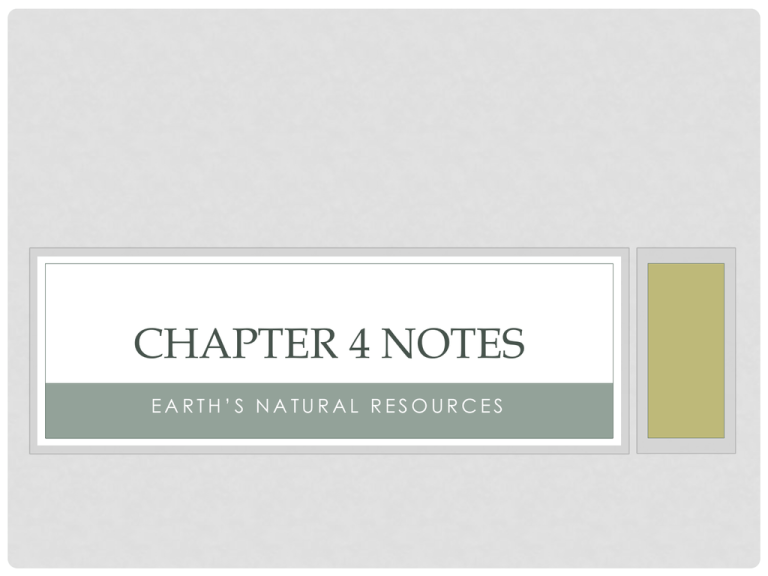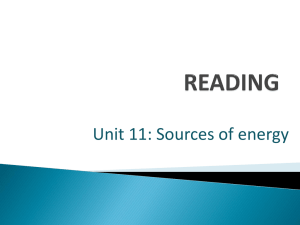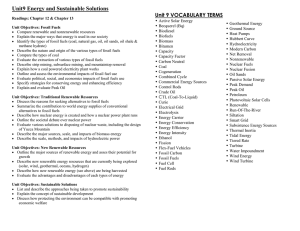Fossil fuels
advertisement

CHAPTER 4 NOTES EARTH’S NATURAL RESOURCES RENEWABLE AND NONRENEWABLE RESOURCES • Renewable resources can be replenished over a fairly short period of time. Examples include plants, animals, water, wind and sun. • Nonrenewable resources take a long period of time to replenish and it is not practical to assume they can be replenished in enough time to be used continuously without exhausting their supply. • Examples of nonrenewable resources include coal, oil, natural gas, gold, copper, minerals etc. FOSSIL FUELS • Fossil fuels are hydrocarbons that are used as a source of energy. • Examples include coal, oil, and natural gas. • Nearly 90% of the energy used in the United States comes from fossil fuels. • Fossil fuels are relatively cheap. • Fossil fuels are nonrenewable. • The by-products of fossil fuels (carbon dioxide, sulfur dioxide etc.) can cause pollution. FOSSIL FUELS SOLAR ENERGY • Solar energy is the direct use of the sun’s rays to supply heat or electricity. • Advantages of solar energy is that it is free, renewable, and non-polluting. • Disadvantages of solar energy is that installation of the technology needed to gather solar energy is expensive and solar energy is not always reliable because of the availability of sunlight. SOLAR ENERGY NUCLEAR ENERGY • Nuclear energy is the use of exothermic nuclear processes to generate useful heat and electricity. • If it could be controlled responsibly and safely it would be a much more efficient way of obtaining energy than using fossil fuels. • Pound per pound nuclear energy contains much more energy than fossil fuels. • It can be dangerous and the waste products produced by nuclear energy are hazardous. NUCLEAR ENERGY WIND ENERGY • Wind energy is the conversion of energy generated by the wind into useful energy through the use of a wind turbine. • Advantages is that it is free, non-polluting, and renewable. • Disadvantages is that the technology required is expensive, it requires large tracts of land, it can be harmful to wildlife (birds mostly), it is not always reliable, and they can generate lots of noise. WIND ENERGY HYDROELECTRIC POWER • Hydroelectric power is the power generated by falling water that turns a turbine which generates electricity. • Water is a renewable resource, but the dams built to harness the hydroelectric power have a limited lifetime. Dams fill in with sediment. • Dams can also have a dramatic effect on wildlife. HYDROELECTRIC POWER GEOTHERMAL ENERGY • Geothermal energy is harnessed by tapping natural underground reservoirs of steam and hot water produced by hot magma. • The hot water can be used directly for heat and also the heat produced can be used to turn a turbine that generates electricity. • Geothermal energy is free and non-polluting, but unfortunately it is not renewable. Eventually, geothermal energy sources are exhaustible. GEOTHERMAL ENERGY TIDAL POWER • Tidal power is harnessed by constructing a dam across the mouth of a bay or an estuary in coastal areas with a large tidal range. • The strong in and out flow generated by the tides drives turbines and electric generators. • You need an area with a strong enough tide for tidal energy to work. TIDAL POWER






